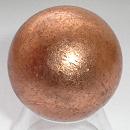|
|
|
|
Click on a letter above to view the list of gems. |
|
|
|
|
|
Copper |
|
| Chemistry: Cu [Elemental Copper] | |
| Discovered
in Prehistory;
IMA
status: Valid (pre-IMA; Grandfathered). | ||
|
| ||
|
Classification |
|
|
| |
|
Elements | |
|
1/A.01-10 | |
|
|
1 : ELEMENTS (Metals and intermetallic alloys; metalloids and
nonmetals; carbides, silicides, nitrides, phosphides) |
|
Related to: |
Copper Group. Copper - Cupalite Family. Copper - Silver - Gold Series |
|
|
|
|
Crystal Data |
|
|
|
|
|
As cubes, dodecahedra, and as tetrahexahedra; rarely as octahedra and complex combinations. Commonly flattened on [111], elongated along [001]. Also as irregular distortions, in twisted, wirelike shapes; filiform, arborescent, massive; as a coarse powder. Masses weighing hundreds of tons have been found; crystals up to 15 cm. |
|
|
On [111] to produce simple contact and penetration twins and cyclic groups. |
|
|
|
|
|
Physical Properties |
|
|
|
|
|
None Observed |
|
|
Hackly, Jagged |
|
|
Highly Malleable and Ductile |
|
|
2.5 - 3.0 |
|
|
8.94 - 8.95 (g/cm3) |
|
|
None |
|
|
Not Radioactive |
|
|
Other: |
Highly Conductive |
|
|
|
|
Optical Properties |
|
|
|
|
|
Copper-Red; tarnishes to Black or Green in air |
|
|
Opaque |
|
|
Metallic |
|
|
R: (400) 45.0, (420) 47.9, (440) 51.3, (460) 54.4, (480) 56.9, (500) 58.9, (520) 60.5, (540) 63.0, (560) 70.5, (580) 86.1, (600) 95.9, (620) 98.4, (640) 98.7, (660) 98.7, (680) 98.7, (700) 98.7 |
|
|
None; Opaque |
|
|
None |
|
|
|
|
|
Occurances |
|
|
|
|
|
Geological Setting: |
Commonly associated with porous zones in mafic extrusive rocks, less commonly in sandstones and shales, where the copper was probably of hydrothermal origin, precipitated as the result of oxidizing conditions; in the oxidized zone of large, disseminated copper deposits as a result of secondary processes. A rare mineral in some meteorites. |
|
Common Associations: |
Azurite, Bornite, Chalcocite, Cuprite, Iron Oxides, Malachite, Silver, Tenorite, many other minerals. |
|
Type Locality: |
Prehistic; possibly Middle East; possibly northern Iraq |
|
Year Discovered: |
Prehistic; possibly around 9000 BC |
|
View mineral photos: | |
|
|
|
|
More Information |
|
|
|
|
|
| |
|
|
|
|
Copper
occurs in many localities worldwide. Some of the
most notable are the deposits of the Keweenaw Peninsula,
Keweenaw and Houghton Counties, Michigan, USA; in several
copper deposits in Arizona, USA including those at the New
Cornelia mine, Ajo, Pima County; the Copper Queen mine
at Bisbee, Cochise County; and at Ray, Gila County,
Arizona. |
|
|
We
have not photographed our Copper gems. Please
check back soon. |
